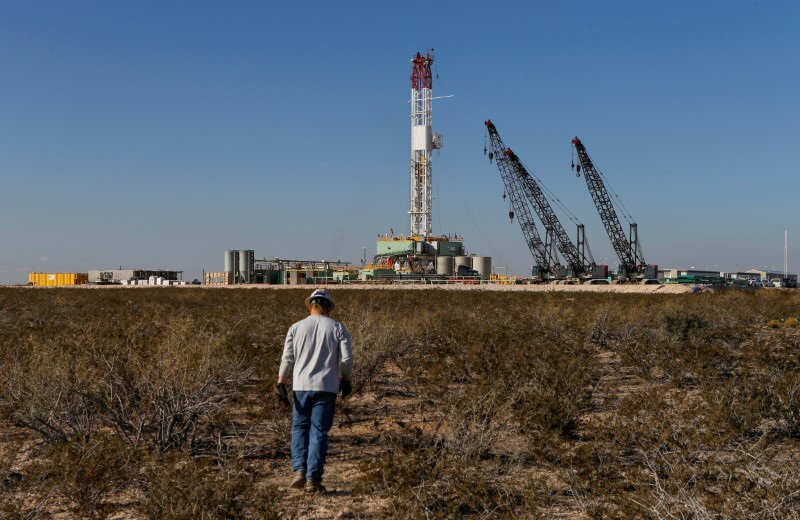Commodities
Oil posts 3% weekly gains on positive economic data, rate cut hopes

By Arathy Somasekhar
HOUSTON (Reuters) -Oil prices settled higher on Friday and notched over 3.5% in weekly gains as positive economic data and signals from Fed policymakers that they could cut interest rates as early as September eased demand concerns, while fears of a widening Middle East conflict continue to raise supply risks.
futures settled 50 cents up, or 0.6%, at $79.66 a barrel, while U.S. West Texas Intermediate crude futures rose 65 cents, or 0.9%, to $76.84. both benchmarks.
Brent gained more than 3.5% in the week, while WTI rose more than 4%.
“Crude is in a recovery mode … as geopolitical tensions still seem to be a positive factor, and on-again off-again recession fears have calmed a bit, at least for now,” said Dennis Kissler, senior vice president of trading at BOK Financial.
A trio of Federal Reserve policymakers indicated on Thursday that they were more confident that inflation is cooling enough to cut rates. A bigger-than-expected fall in U.S. jobless claims data also helped to underpin the recovery.
The number of Americans filing new applications for unemployment benefits fell more than expected last week, suggesting that fears the labor market is unraveling were overblown and that the gradual softening in the labor market remains intact.
Also offering support was China’s consumer price index, which rose last month at a slightly faster than expected rate, statistics bureau data showed.
“Positive momentum was further reinforced by Chinese inflation numbers that exceeded expectations. In this context, it wouldn’t be surprising to see the price per barrel testing the $80 level,” said Pierre Veyret, Technical Analyst at ActivTrades.
“The price per barrel has benefited from rising geopolitical tensions in the Middle East, which have fuelled fears of a potential conflict that could disrupt the region’s output and reduce the global supply of crude,” Veyret added.
Israeli forces stepped up airstrikes across the Gaza Strip on Thursday, killing at least 40 people, Palestinian medics said, in further battles with Hamas-led militants.
The killing last week of senior members of militant groups Hamas and Hezbollah had raised the possibility of retaliatory strikes by Iran against Israel, stoking concerns over oil supply from the world’s largest producing region.
Iran-aligned Houthi militants have also continued attacks on international shipping near Yemen in solidarity with Palestinians in the war between Israel and Hamas.
Leaders of the United States, Egypt and Qatar on Thursday called on Israel and Hamas to meet for negotiations on Aug. 15 in order to finalize a Gaza ceasefire and hostage release deal.
The Russia-Ukraine conflict also continued as Moscow moved extra tanks, artillery and rocket systems to its southern Kursk region on Friday as it battled for the fourth straight day to end a shock incursion by Ukrainian forces.
Meanwhile, the , which measures the currency against six others, was down 0.136% at 103.14 following three days of gains. A weaker greenback helps demand as oil becomes cheaper for foreign buyers.
Lending further support to prices, Libya’s National Oil Corp declared force majeure at its Sharara oilfield from Wednesday, adding that it had gradually reduced the field’s output because of protests.

However, U.S. oil rigs, an indicator of future production, rose by three to 485 this week.
Money managers cut their net long futures and options positions in the week to August 6, the U.S. Commodity Futures Trading Commission (CFTC) said.
Commodities
Oil prices rise; U.S. crude inventories plunge, Russia-Ukraine truce eyed
Commodities
India’s Reliance to stop buying Venezuelan oil over US tariffs, sources say
Commodities
Oil prices climb on Venezuela supply worries

 Forex3 years ago
Forex3 years agoForex Today: the dollar is gaining strength amid gloomy sentiment at the start of the Fed’s week

 Forex3 years ago
Forex3 years agoUnbiased review of Pocket Option broker

 Forex3 years ago
Forex3 years agoDollar to pound sterling exchange rate today: Pound plummeted to its lowest since 1985

 Forex3 years ago
Forex3 years agoHow is the Australian dollar doing today?

 Cryptocurrency3 years ago
Cryptocurrency3 years agoWhat happened in the crypto market – current events today

 World3 years ago
World3 years agoWhy are modern video games an art form?

 Commodities3 years ago
Commodities3 years agoCopper continues to fall in price on expectations of lower demand in China

 Economy3 years ago
Economy3 years agoCrude oil tankers double in price due to EU anti-Russian sanctions



























